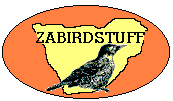

The Atlas of Southern African
Birds
Published by
The Atlas of Southern African Birds has just come out and is no less than an historic event in Bird Book Publishing. Read our review below.
URGENT: You
can still get an Atlas from BirdLife SA (25 August)
You'll kick yourself if you don't. (details at the
bottom of this page)
The Atlas is an impressive and handsome two volume set. It's sheer bulk (6kg) inspires curiosity - and no small measure of anticipation ! The style of the book as scientific without being overly inaccessible to the lay-birder. Volume 1 contains a detailed introduction on the South African Bird Atlas Project and the methodology used. A chapter on the geography of the region then covers issues of habitat and conditions which influence bird distribution. This is quite comprehensive and includes photographs of different habitat types. The short guide to species accounts which follows (in both volumes) is worth reading in order to understand how the Atlas data is presented.
The species accounts are far more than an account of distribution and maps. A wealth of information is presented on each species, including a detailed account of habitat, numbers, breeding distribution, movements, relations with other species and how the distribution has changed over time. Those frustratingly vague distribution maps in our field guides are a thing of the past, as the Atlas provides a new level of detail (on the better known species). Overall the text provides a wonderfully accessible account of the bird in question, bringing together research and insights which only the most hardened researcher would have previously been able to access. The fact that the sources of such information is meticulously referenced ensures that the atlas will be a key resource for anyone wanting to know more about any species or group of birds.
The Distribution Maps are in many cases an eye opener. One might have hoped that the distribution of a conspicous bird like the Black Crow would have been fairly well known - but the Atlas shows the distribution maps in Roberts, Newmans and Sasol to be way off ! Sightings of Pallid and Montagu's Harrier which attracted sceptism were found to be part of a known pattern. Distribution ranges of uncommon species like the Yellowthroated Sandgrouse are far more clearly defined which means that one knows where in the Northwest Provinces to go looking to tick this bird off. The same applies to Delegorgue's pigeon which was recorded in only 7 grid squares within South Africa. I will be looking out for the Greybacked Finchlark much further east than I had previously thought possible. In addition to the maps, accounts for most species include a graph showing the relative reporting rates for different vegetation types. In many cases this is really interesting, as it indicates how abundance varies according to the favoured habitat types. In addition, the species accounts show the seasonality of records, and this is further seperated by region. This enables one to get a picture of seasonal movement, and of the likelihood of ticking a species at different times of the year. The Pearlbreasted Swallow for example is shown to be largely absent from the (old) Cape Province Region in winter, at which time it is more common in the Transvaal. In many cases breeding data is also shown by region and superimposed on the charts indicating seasonality. For each species the map has its own "reporting rates" key which enables one to compare the reporting rates for different species (and in different areas).
Although it takes a bit of practise to get used to the charts, the amount of information presented for the better known species is breathtaking ! Because the maps are detailed, one finds oneself wanting to know exactly where the grid blocks in a particular region are - and this is difficult to do unless you are very familiar with the grid references. Perhaps a set of accessory transparent maps will become available which will enable one to more easily place oneself in relation to the data presentation.
Overall the Atlas is a superb book, and will make a major contribution to birding in the region. Apart from that is an invaluable resource for conservation and further research. The Atlas will no doubt soon be the essential reference book for all serious birders, as well as a collectors item !
The pre-publication offer on Atlases has now expired. You can still get one from BirdlifeSA at a discount price of R660-00. They can be contacted by e-mail, fax 011 782 7013 or phone 011 888 4147. e-mail Birdlife South Africa